Efficiency and Sustainability of Ips duplicatus (Coleoptera: Curculionidae) Pheromone Dispensers with Different Designs
Abstract
1. Introduction
2. Materials and Methods
2.1. Dispensers Used
2.2. Dispenser Tests in Lab Conditions
2.2.1. Comparison of Release Rates of Dispenser Types
2.2.2. Headspace Analysis of Proportion of Active Compounds in the Tested Dispensers
2.3. Field Experiments
2.4. Collection and Processing of Trapped Insects
2.5. Data Analysis
3. Results
3.1. Dispenser Tests in Lab Conditions
3.1.1. Comparison of Release Rates of Dispenser Types
3.1.2. Headspace Analysis of Proportions of Active Compounds in Tested Dispensers
3.2. Ips duplicatus Response to Tested Dispensers
3.2.1. Total Captures
The Experiment Conducted in 2011 (18 April–21 June) (Romania)
3.2.2. Capture Dynamics
The Experiment Conducted in 2011 (18 April–21 June) (Romania)
The Experiment Conducted in 2017 (7 July–15 August) (The Czech Republic)
3.3. Ips Typographus Response of Tested Dispensers
4. Discussions
4.1. Dispenser Tests in Lab Conditions
4.2. Ips duplicatus Response to the Tested Dispensers
4.3. Ips Typographus Response to the Tested Dispensers
4.4. Limitation of the Study
5. Conclusions
Supplementary Materials
Author Contributions
Funding
Conflicts of Interest
Abbreviations
References
- Pfeffer, A. Zentral-Und Westpaläarktische Borken-Und Kernkäfer: (Coleoptera: Scolytidae, Platypodidae); Pro Entomologia, c/o Naturhistorisches Museum: Basel, Switzerland, 1995; p. 310. [Google Scholar]
- Bakke, A. Aggregation pheromone in the bark beetle Ips duplicatus (Sahlberg). Norw. J. Ent. 1975, 22, 67–69. [Google Scholar]
- Voolma, K. Bark beetles (Coleoptera, Scolytidae) as a disturbance agents in the forest in Estonia. In Proceedings of the Forest Insect Epidemics—Population Dynamics, Dispersal and Ecosystem Impacts, Prince George, BC, Canada, 11–14 July 2005; pp. 41–42. [Google Scholar]
- Schedl, K.E. 91. Familie: Scolytidae (Borken-und Ambrosiakäfer). In Die Käfer Mitteleuropas; Freude, H., Harde, K.W., Lohse, G.A., Eds.; Spektrum Akademischer Verlag: Heidelberg, Germany, 1981; Volume 10, pp. 34–99. [Google Scholar]
- Zhang, Q.-H.; Schlyter, F.; Liu, G.-T. Distribution, mortality, and sex ratio of overwitering Ips duplicatus (Coleoptera: Scolytinae) in the soil of Picea koraiensis reserve in Inner Mongolia, China, with a model of diffusion. In Proceedings of the Behaviour, Population Dynamics and Control of Forest Insects, Maui, HI, USA, 6–11 February 1994; pp. 109–122. [Google Scholar]
- Holuša, J.; Grodzki, W. Occurrence of Ips duplicatus (Coleoptera: Curculionidae, Scolytinae) on pines (Pinus sp.) in the Czech Republic and southern Poland—Short communication. J. For. Sci. 2008, 54, 234–236. [Google Scholar] [CrossRef]
- Negru, Ș.; Ceianu, I. Contribuţiune la recunoasterea lui Ips duplicatus Sahlb. (Coleoptera, Ipidae) si a vătămării. An. Univ. C.I. Parhon Bucur. Ser. Stiinţele Nat. 1957, 13, 157–160. [Google Scholar]
- Vakula, J.; Zúbrik, M.; Galko, J.; Gubka, A.; Kunca, A.; Nikolov, C.; Saniga, M.; Zach, P. Is the double-spined bark beetle Ips duplicatus a new threat to Picea omorika in urban habitats? Plant Prot. Sci. 2021, 57, 248–251. [Google Scholar] [CrossRef]
- Duduman, M.L.; Isaia, G.; Olenici, N. Ips duplicatus (Coleoptera: Curculionidae, Scolytinae) distribution in Romania. Preliminary results. Bull. Transilv. Univ. Braşov Ser. II 2011, 53, 19–27. [Google Scholar]
- Holusa, J.; Lubojacky, J.; Knizek, M. Distribution of the double-spined spruce bark beetle Ips duplicatus in the Czech Republic: Spreading in 1997–2009. Phytoparasitica 2010, 38, 435–443. [Google Scholar] [CrossRef]
- Grodzki, W. Distribution range of the double spined bark beetle Ips duplicatus C.R. Sahlb. (Col.: Scolytidae) in the mountain areas of southern Poland. Sylwan 2003, 8, 29–36. [Google Scholar]
- Wermelinger, B.; Mathis, D.S.; Knížek, M.; Forster, B. Tracking the spread of the northern bark beetle (Ips duplicatus [Sahlb.]) in Europe and first records from Switzerland and Liechtenstein. Alp. Entomol. 2020, 4, 179. [Google Scholar] [CrossRef]
- EPPO. Global Database—Ips duplicatus. Available online: https://gd.eppo.int/taxon/IPSXDU/distribution (accessed on 5 August 2021).
- Piel, F.; Grégoire, J.-C.; Knížek, M. New occurrence of Ips duplicatus Sahlberg in Herstal (Liege, Belgium). EPPO Bull. 2006, 36, 529–530. [Google Scholar] [CrossRef]
- Petercord, R.; Lemme, H. Der Nordische Fichtenborkenkäfer. LWF-Aktuell 2019, 120, 48–50. [Google Scholar]
- Zúbrik, M.; Kunka, A.; Turčani, M.; Vakula, J.; Leontovyc, R. Invasive and quarantine pests in forest in Slovakia. EPPO Bull. 2006, 36, 402–408. [Google Scholar] [CrossRef]
- Vakula, J.; Kunka, A.; Zúbrik, M.; Leontovyc, R.; Longauerová, V.; Gubka, A. Distribution of two invasive pests in Slovakia since 1996. In Alien Invasive Species and International Trade; Evans, H., Oszako, T., Eds.; Forest Research Institute: Warsaw, Poland, 2007; pp. 105–113. [Google Scholar]
- DAISE. Handbook of Alien Species in Europe; Springer: Berlin/Heidelberg, Germany, 2009; p. 399. [Google Scholar]
- Olenici, N.; Duduman, M.-L.; Olenici, V.; Bouriaud, O.; Tomescu, R.; Rotariu, C. The First outbreack of Ips duplicatus in Romania. In Proceedings of the Working Party 7.03.10 Methodology of Forest Insect and Disease Survey in Central Europe, 10th Workshop, Freiburg, Germany, 20–23 September 2010; pp. 135–140. [Google Scholar]
- Olenici, N.; Duduman, M.-L.; Tulbure, C.; Rotariu, C. Ips duplicatus (Coleoptera, Curculionidae, Scolytinae)—An important insect pest of Norway spruce planted outside its natural range. Rev. Pădurilor 2009, 124, 17–23. [Google Scholar]
- Knizek, M.; Zahradnik, P. Mass outbreak of Ips duplicatus Sahlberg (Coleoptera: Scolytidae). In Proceedings of the XX International Congress of Entomology, Firenze, Italy, 25–31 August 1996; p. 527. [Google Scholar]
- Duduman, M.-L.; Olenici, N.; Nuțu, A. Comparative analysis of development duration of Ips duplicatus and Ips typographus bark beetles. In Proceedings of the IUFRO WP 7.03.10 Methodology of Forest Insect and Disease Survey in Central Europe. Conference “Fluctuation of Insects and Diseases”, San Michele all’Adige, Italy, 22–26 June 2015; p. 13. [Google Scholar]
- Holusa, J.; Zahradnik, P.; Knizek, M.; Drápela, K. Seasonal flight activity of the double-spined spruce bark-beetle Ips duplicatus (Coleoptera, Curculionidae, Scolytinae) in Silesia (Czech Republic). Sect. Zool. 2003, 58, 935–941. [Google Scholar]
- Duduman, M.-L.; Olenici, N.; Isaia, G. Research Carried Out in Romania on the Northern Bark Beetle (Ips duplicatus, Coleoptera: Curculionidae, Scolytinae). In Proceedings of the Biennial International Symposium Forest and Sustainable Development, Brasov, Romania, 19–20 October 2012; pp. 9–14. [Google Scholar]
- Vakula, J.; Kunca, A.; Barta, M.; Lalík, M.; Galko, J.; Gubka, A.; Zúbrik, M.; Rell, S.; Nikolov, C. Vertical transmission of the Beauveria bassiana between the double-spined bark beetle Ips duplicatus. In Proceedings of the Recent Changes in Forest Insects and Pathogens Significance. IUFRO WP 7.03.10. Methodology of Forest Insect and Disease Survey in Central Europe, Suceava, Romania, 16–20 September 2019; p. 87. [Google Scholar]
- Grodzki, W. Two types of Norway spruce Picea abies (L.) H. Karst. infestation by the double spined bark beetle Ips duplicatus C.R. Sahlb. (Coleoptera: Scolytinae) in southern and northeastern Poland. Folia For. Pol. Ser. A 2012, 54, 169–174. [Google Scholar]
- Grodzki, W. Parazytoidy, drapiezce i komensale kambiofagow swierka w warunkach zubozenia roznorodnosci biologicznej ekosystemow lesnych sudetow. Pr. Inst. Badaw. Lesn. Ser. A 1997, 836, 193–213. [Google Scholar]
- Holuša, J. Is dying of spruce forests in Silesia a result of drought, fungi or bark beetles? J. For. Sci. 2001, 47, 100. [Google Scholar]
- Turčáni, M.; Hlásny, T. Spatial distribution of four spruce bark beetles in north-western Slovakia. J. For. Sci. 2007, 53, 45–53. [Google Scholar] [CrossRef]
- Olenici, N.; Olenici, V. Pristiphora abietina (Christ) (Hymenoptera, Tenthredinidae)—Un dăunător important al molidului din afara arealului natural de vegetaţie. Rev. Pădurilor 2005, 120, 3–13. [Google Scholar]
- Šotola, V.; Holuša, J.; Kuželka, K.; Kula, E. Felled and Lure Trap Trees with Uncut Branches Are Only Weakly Attractive to the Double-Spined Bark Beetle, Ips duplicatus. Forests 2021, 12, 941. [Google Scholar] [CrossRef]
- Holuša, J.; Knizek, M. Lýkožrout severský Ips duplicatus (Sahlberg). Lesn. Práce 2007, 4, 4. [Google Scholar]
- Kausrud, K.; Økland, B.; Skarpaas, O.; Grégoire, J.-C.; Erbilgin, N.; Stenseth, N.C. Population dynamics in changing environments: The case of an eruptive forest pest species. Biol. Rev. 2012, 87, 34–51. [Google Scholar] [CrossRef]
- Chen, G.; Zhang, Q.-H.; Wang, Y.; Liu, G.-T.; Zhou, X.; Niu, J.; Schlyter, F. Catching Ips duplicatus (Sahlberg) (Coleoptera: Scolytidae) with pheromone-baited traps: Optimal trap type, colour, height and distance to infestation. Pest Manag. Sci. 2009, 66, 213–219. [Google Scholar] [CrossRef]
- Duduman, M.L.; Vasian, I. Synthetic Bait for Spruce Bark Beetle, Ips duplicatus. Romanian Patent RO129688-B1, 30 October 2019. [Google Scholar]
- Holuša, J.; Grodzki, W.; Lukašová, K.; Lubojacký, J. Pheromone trapping of the double-spined bark beetle Ips duplicatus (Coleoptera: Curculionidae, Scolytinae): Seasonal variation in abundance. Folia For. Pol. 2013, 55, 3–9. [Google Scholar] [CrossRef]
- Schlyter, F.; Birgersson, G. Forest Beetless. In Pheromones of Non-Lepidopteran Insects Associated with Agricultural Plants; Hardie, R.J., Minks, A.K., Eds.; CAB International: Wallingford, UK, 1999; pp. 113–148. [Google Scholar]
- Byers, J.; Zhang, Q. Chemical Ecology of Bark Beetles in Regard to Search and Selection of Host Trees. In Recent Advances in Entomological Research; Liu, T., Kang, L., Eds.; Springer: Berlin/Heidelberg, Germany, 2012; pp. 150–190. [Google Scholar] [CrossRef]
- Ivarsson, P.; Schlyter, F.; Birgersson, G. Demonstration of de Novo pheromone biosynthesis in Ips duplicatus (Coleoptera: Scolytidae): Inhibition of Ipsdienol and E-Myrcenol production by compactin. Insect Biochem. Mol. Biol. 1993, 23, 655–662. [Google Scholar] [CrossRef]
- Byers, J.A.; Schlyter, F.; Birgersson, G.; Francke, W. E-myrcenol in Ips duplicatus: An aggregation pheromone component new for bark beetles. Experientia 1990, 46, 1209–1211. [Google Scholar] [CrossRef]
- Schlyter, F.; Birgersson, G.; Byers, J.; Bakke, A. The aggregation pheromone of Ips duplicatus and its role in competitive interactions with I. typographus (Coleoptera: Scolytidae). Chemoecology 1992, 3, 103–112. [Google Scholar] [CrossRef]
- Schlyter, F.; Zhang, Q.-H.; Liu, G.-T.; Ji, L.-Z. A successful Case of Pheromone Mass Trapping of the Bark Beetle Ips duplicatus in a Forest Island, Analysed by 20-Year Time-Series Data. Integr. Pest Manag. Rev. 2001, 6, 185–196. [Google Scholar] [CrossRef]
- Schlyter, F.; Svensson, M.; Zhang, Q.-H.; Knízek, M.; Krokene, P.; Ivarsson, P.; Birgersson, G. A Model for Peak and Width of Signaling Windows: Ips duplicatus and Chilo partellus Pheromone Component Proportions—Does Response Have a Wider Window Than Production? J. Chem. Ecol. 2001, 27, 1481–1511. [Google Scholar] [CrossRef]
- Zhang, Q.H.; Schlyter, F.; Liu, G.T.; Sheng, M.L.; Birgersson, G. Electrophysiological and behavioral responses of Ips duplicatus to aggregation pheromone in Inner Mongolia, China: Amitinol as a potential pheromone component. J. Chem. Ecol. 2007, 33, 1303–1315. [Google Scholar] [CrossRef]
- Duduman, M.-L. Field response of the northern spruce bark beetle Ips duplicatus (Sahlberg) (Coleoptera: Curculionidae, Scolytinae) to different combinations of synthetic pheromone with (−)-α-pinene and (+)-limonene. Agric. For. Entomol. 2014, 16, 102–109. [Google Scholar] [CrossRef]
- Göktürk, T.; Akkuzu, E.; Yaşar, A. Comparing the effectiveness ratios of pheromone lures of IPSOWIT®, IPSTYP®, and TYPOSAN® against Ips typographus (L.) (Col.: Scolytidae). Artvin Çoruh Üniversitesi Orman Fakültesi Derg. 2011, 6, 155–160. [Google Scholar]
- Zahradník, P.; Zahradníková, M. Evaluation of the efficacy duration of different types of pheromone dispensers to lure Ips typographus (L.) (Coleoptera: Curculionidae: Scolytinae). J. For. Sci. 2014, 60, 456–463. [Google Scholar] [CrossRef]
- Šramel, N.; Kavčič, A.; Kolšek, M.; de Groot, M. Estimating the most effective and economical pheromone for monitoring the European spruce bark beetle. J. Appl. Entomol. 2021, 145, 312–325. [Google Scholar] [CrossRef]
- Holusa, J.; Grodzki, W.; Lukásová, K. Comparison of the pheromone dispensers ID Ecolure, Pheagr IDU and Duplodor for the double spined bark beetle (Ips duplicatus). Sylwan 2010, 154, 363–370. [Google Scholar]
- Fytofarm. ID-Ecolure Etiketa. Available online: http://www.fytofarm.cz/bezpecnostni-listy (accessed on 31 March 2021).
- Minář, P. Seznam Registrovaných Přípravků a Evidovaných Prostředků na Ochranu Rostlin 2008; VěstníkStátní Rostlinolékařské Správy 5 (Zvláštní Vydání). 2008, p. 318. Available online: http://eagri.cz/public/web/file/58051/Rocenka_SRS_2008.pdf (accessed on 3 September 2021).
- Chem-Bar. Feromonový Prostředek na Lákání Lýkožrouta Severského (Ips duplicatus) v Lesních Porostech. Available online: https://www.chem-bar.cz/view/files/files/584.pdf (accessed on 15 August 2021).
- Schlyter, F. Sampling range, attraction range, and effective attraction radius: Estimates of trap efficiency and communication distance in coleopteran pheromone and host attractant systems1. J. Appl. Entomol. 1992, 114, 439–454. [Google Scholar] [CrossRef]
- Holuša, J.; Voigtová, P.; Kula, E.; Křístek, Š. Výskyt lýkožrouta severského (Ips duplicatus Sahlberg, 1836) (Coleoptera: Scolytidae) na LS Bruntál LČR s. p., v roce 2004–2005. Zprav. Ochr. Lesa 2006, 13, 1–46. [Google Scholar]
- Zar, J.H. Biostatistical Analysis, 5th ed.; Pearson Prentice Hall: Hoboken, NJ, USA, 2010. [Google Scholar]
- Wolde-Hawariat, Y.; Seyoum, E.; Jembere, B.; Negash, M.; Hansson, B.S.; Hillbur, Y. Behavioural and electrophysiological Response of sorghum chafer Pachnoda interrupta (Coleoptera: Scarabaeidae) to plant compounds. Int. J. Trop. Insect Sci. 2007, 27, 53–61. [Google Scholar] [CrossRef]
- Nielsen, M.-C.; Sansom, C.E.; Larsen, L.; Worner, S.P.; Rostás, M.; Chapman, R.B.; Butler, R.C.; de Kogel, W.J.; Davidson, M.M.; Perry, N.B.; et al. Volatile compounds as insect lures: Factors affecting release from passive dispenser systems. N. Zeal. J. Crop Hortic. Sci. 2019, 47, 208–223. [Google Scholar] [CrossRef]
- Torr, S.J.; Hall, D.R.; Phelps, R.J.; Vale, G.A. Methods for dispensing odour attractants for tsetse flies (Diptera: Glossinidae). Bull. Entomol. Res. 1997, 87, 299–311. [Google Scholar] [CrossRef]
- Heuskin, S.; Verheggen, F.J.; Haubruge, E.; Wathelet, J.-P.; Lognay, G. The use of semiochemical slow-release devices in integrated pest management strategies. Biotechnol. Agron. Soc. Environ. 2011, 15, 459–470. [Google Scholar]
- Alfaro-Cid, E.; Esparcia-Alcázar, A.I.; Moya, P.; Femenia-Ferrer, B.; Sharman, K.; Merelo, J. Modeling pheromone dispensers using genetic programming. In Workshops on Applications of Evolutionary Computation; Springer: Berlin/Heidelberg, Germany, 2009; pp. 635–644. [Google Scholar]
- Bakthavatsalam, N. Chapter 19—Semiochemicals. In Ecofriendly Pest Management for Food Security; Omkar, Ed.; Academic Press: San Diego, CA, USA, 2016; pp. 563–611. [Google Scholar] [CrossRef]
- Duduman, M.-L.; Olenici, N.; Olenici, V.; Rotariu, C.; Tulbure, C. The flight activity of Ips typographus and Ips duplicatus adults along of one altitudinal transect. In Proceedings of the XXI National SLR Symposium, Cluj Napoca, Romania, 16–17 April 2011. The Value of the Entomofauna in Romania. [Google Scholar]
- Holuša, J.; Lukášová, K.; Lubojacký, J. Comparison of seasonal flight activity of ips typographus and Ips duplicatus. Sci. Agric. Bohem. 2012, 43, 109–115. [Google Scholar]
- Franklin, A.; Gregoire, J.C. Dose-dependent response and preliminary observations on attraction range of Ips typographus to pheromones at low release rates. J. Chem. Ecol. 2001, 27, 2425–2435. [Google Scholar] [CrossRef]
- Schlyter, F.; Byers, J.A.; Lofqvist, J. Attraction to pheromone sources of different quantity, quality and spacing: Density-Regulatio Mehanisms in Bark Beetle Ips typographus. J. Chem. Ecol. 1987, 13, 1503–1522. [Google Scholar] [CrossRef]
- Weslien, J.; Bylund, H. The number and sex of spruce bark beetles, Ips typographus (L.), caught in pheromone traps as related to flight season, trap type, and pheromone release. J. Appl. Ent. 1988, 106, 488–493. [Google Scholar] [CrossRef]
- Jakus, R.; Simko, J. The use of dispensers with different release rates at pheromone trap barriers for Ips typographus. Anz. Schadl. J. Pest Sci. 2000, 73, 33–36. [Google Scholar] [CrossRef]
- Duduman, M.-L.; Vasian, I. Effects of Volatile Emissions of Picea abies Fresh Debris on Ips duplicatus Response to Characteristic Synthetic Pheromone. Not. Bot. Horti Agrobot. Cluj-Napoca 2012, 40, 308–313. [Google Scholar] [CrossRef][Green Version]
- Nakládal, O.; Sova, J. Comparison of two types of ECOLURE lure on Ips typographus (L.) (Coleoptera: Scolytidae). J. For. Sci. 2010, 56, 609–613. [Google Scholar] [CrossRef]
- Duduman, M.-L.; Olenici, N. Non-target Bark Beetles in Ips duplicatus (Sahlberg) Pheromone Traps Baited with Host Volatiles. Not. Bot. Horti Agrobot. Cluj-Napoca 2015, 43, 576–581. [Google Scholar] [CrossRef]
- Juráň, S.; Pallozzi, E.; Guidolotti, G.; Fares, S.; Šigut, L.; Calfapietra, C.; Alivernini, A.; Savi, F.; Večeřová, K.; Křůmal, K.; et al. Fluxes of biogenic volatile organic compounds above temperate Norway spruce forest of the Czech Republic. Agric. For. Meteorol. 2017, 232, 500–513. [Google Scholar] [CrossRef]
- Faccoli, M.; Buffo, E. Seasonal variability of sex-ratio in Ips typographus (L.) pheromone traps in a multivoltine population in the Southern Alps. J. Pest Sci. 2004, 77, 123–129. [Google Scholar] [CrossRef]
- Blaženec, M.; Majdák, A.; Jakuš, R. Improvement of catches in pheromone trap barriers by altering of sex assigned pheromone blends. Folia Oecol. 2021, 48, 25–34. [Google Scholar] [CrossRef]
- Heber, T.; Helbig, C.E.; Osmers, S.; Müller, M.G. Evaluation of Attractant Composition, Application Rate, and Trap Type for Potential Mass Trapping of Ips typographus (L.). Forests 2021, 12, 1727. [Google Scholar] [CrossRef]
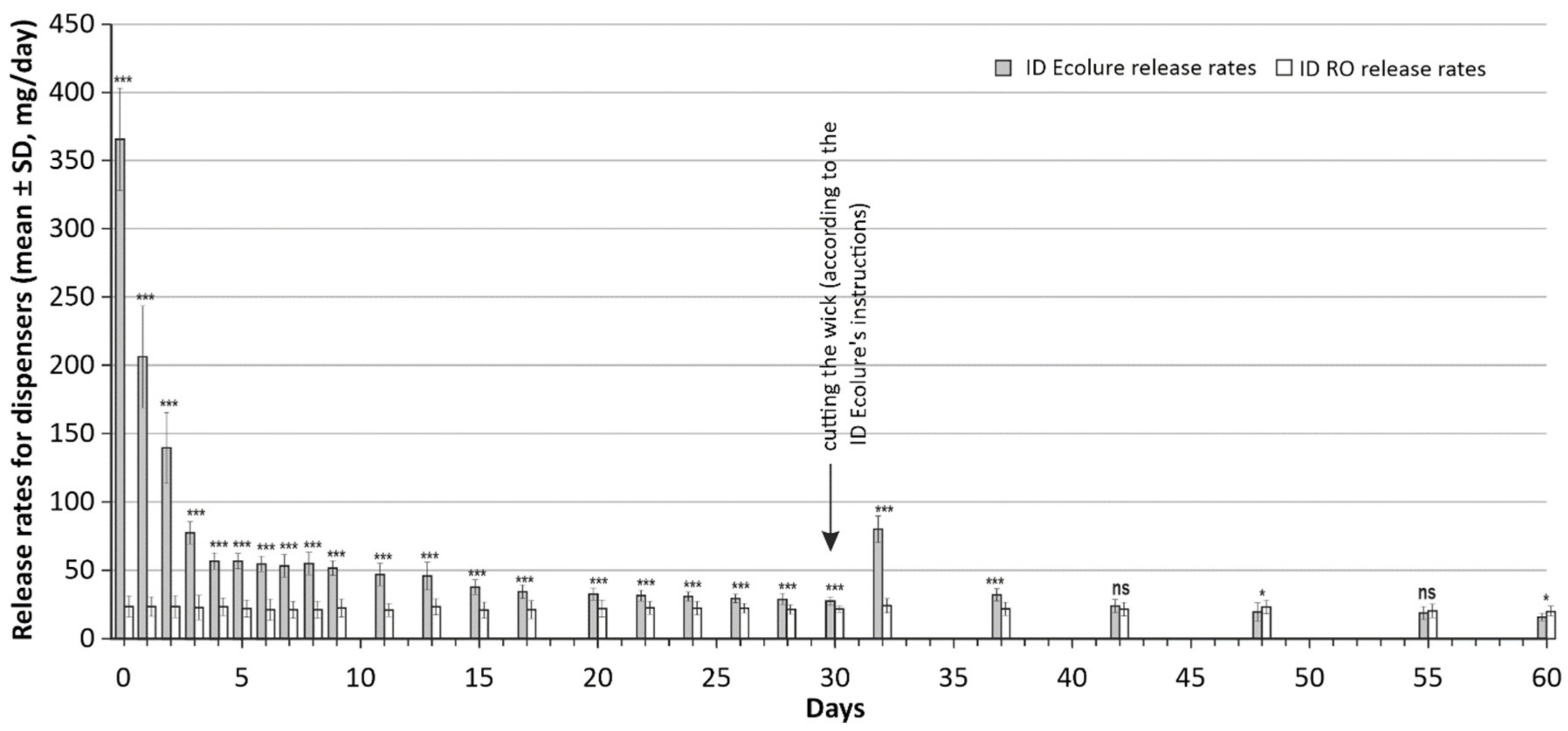

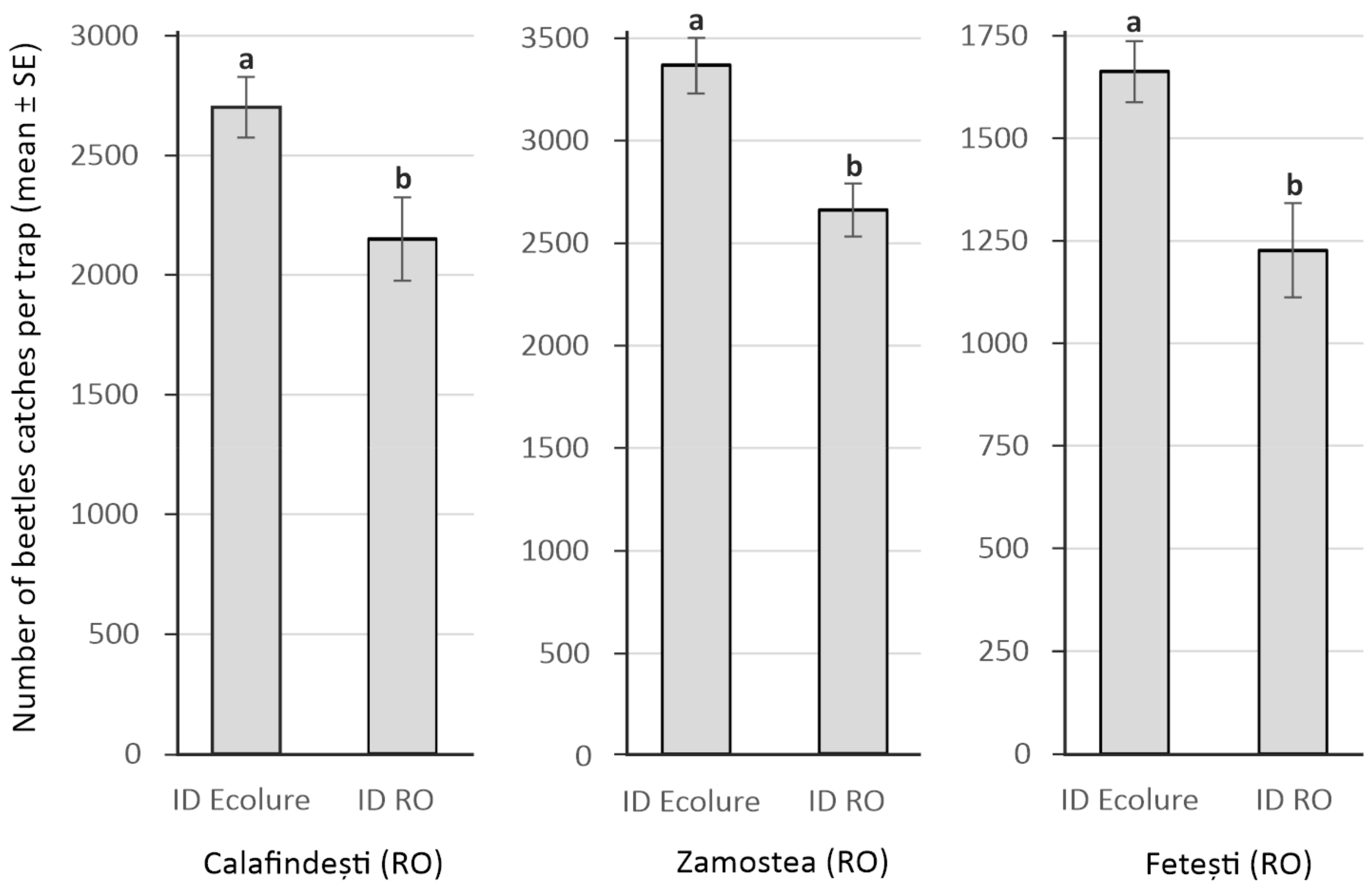
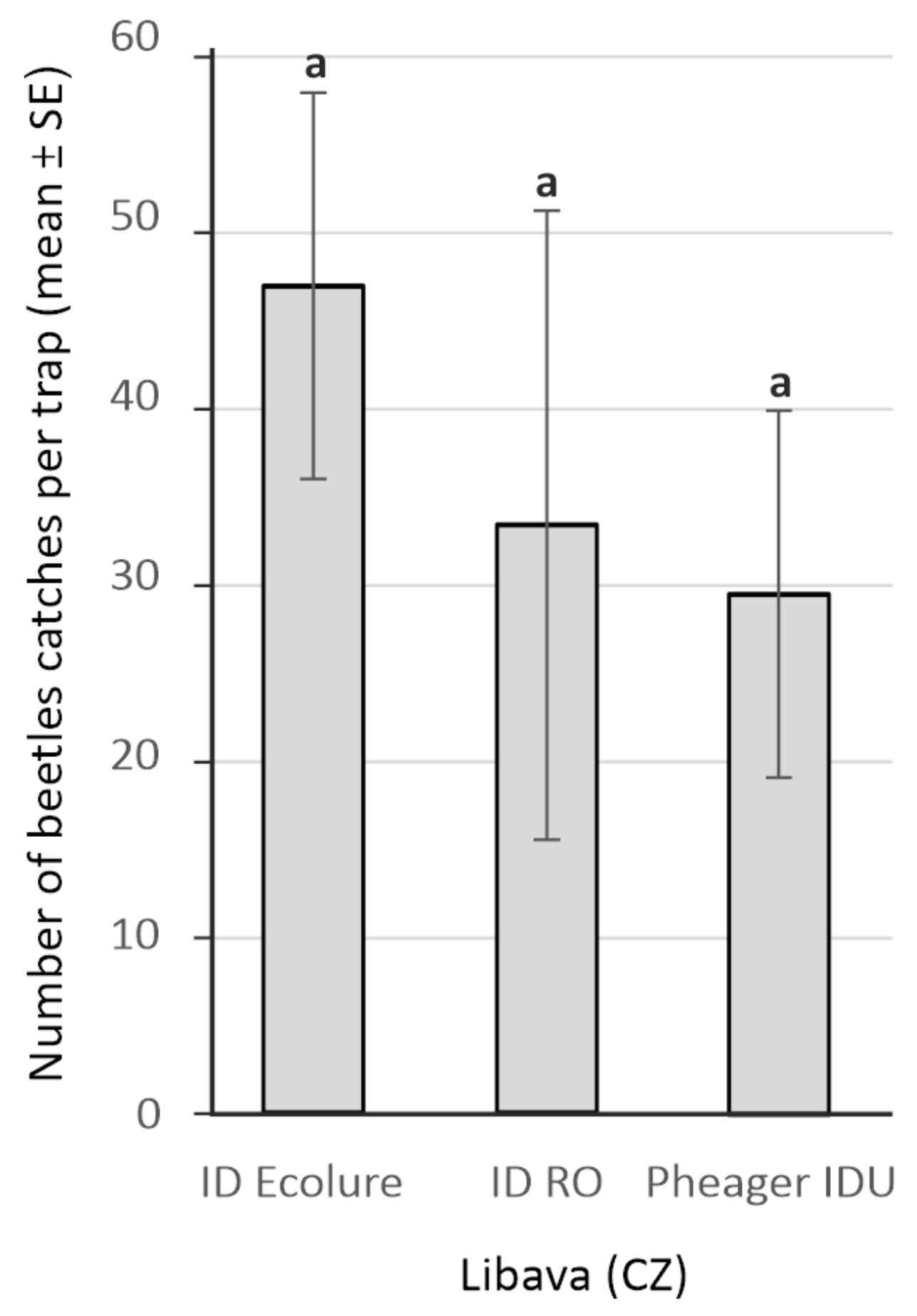
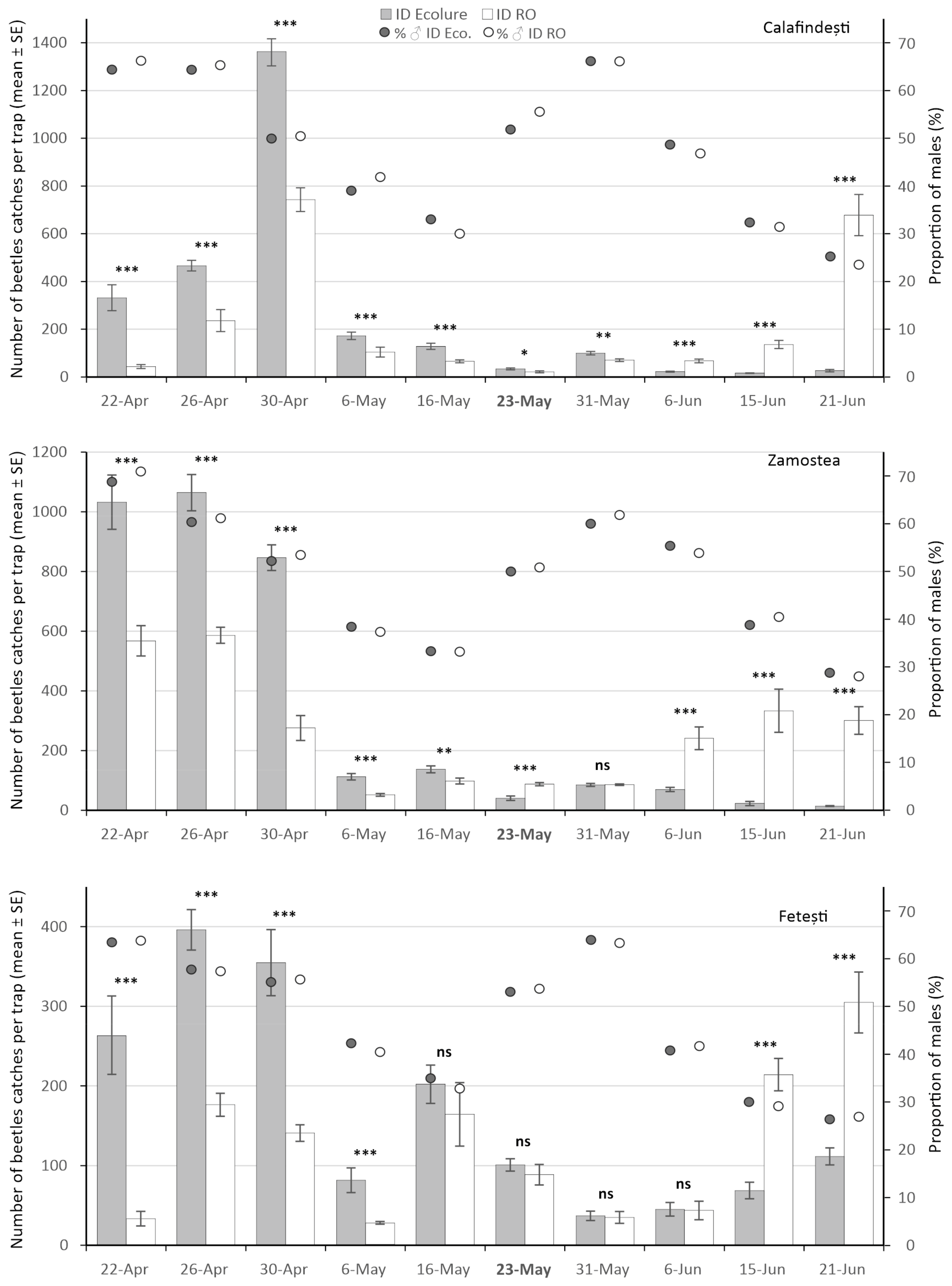
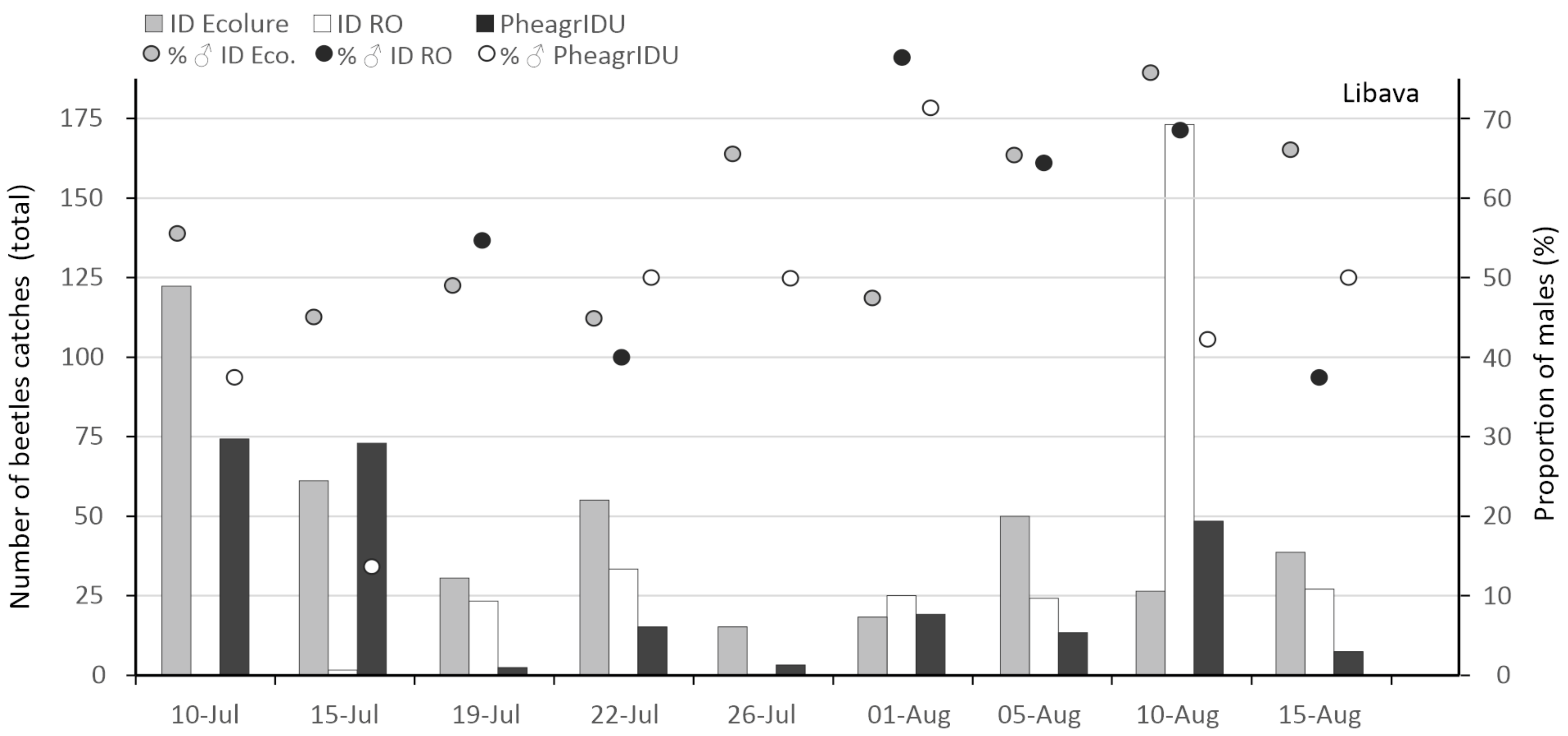
| % of Main Active Compounds † | |||||
|---|---|---|---|---|---|
| 1D RT (s) | 2D RT (s) | ID Ecolure | ID RO | Pheagr IDU | |
| ethanol | 225 | 0.97 | 45.25 | 0.30 | 58.39 |
| α-pinene (AP) | 537 | 1.19 | 42.12 | 9.14 | 12.41 |
| limonene (L) | 648 | 1.31 | 12.51 | 5.78 | 4.27 |
| ipsdienol (Id) | 777 | 1.54 | 0.10 | 77.07 | 24.88 |
| E-myrcenol (EM) | 885 | 1.58 | 0.02 | 7.71 | 0.04 |
| Ratio: | |||||
| Id/EM | 5 | 10 | 565 | ||
| Solvent | 255 | 1.27 | MB | MB | MB |
| Presence of BHT | 1146 | 1.56 | traces | Yes | Yes |
| Location | Number of I. duplicatus | ||
|---|---|---|---|
| Total | Traps Baited with | ||
| ID Ecolure | ID RO | ||
| Calafindești | 24,029 | 13,256 | 10,773 |
| Zamostea | 30,214 | 17,113 | 13,101 |
| Fetești | 14,446 | 8313 | 6133 |
| Statistical Value | d.f. | F | p | d.f. | F | p | d.f. | F | p |
|---|---|---|---|---|---|---|---|---|---|
| Location | Calafindești | Zamostea | Fetești | ||||||
| Dispenser type | 1 | 11.0293 | 0.0043 | 1 | 23.4236 | 0.0002 | 1 | 18.4709 | 0.0006 |
| Beetle sex | 1 | 1.7082 | 0.2097 | 1 | 1.4547 | 0.2453 | 1 | 3.0260 | 0.1011 |
| Dispenser type × beetle sex | 1 | 1.9773 | 0.1788 | 1 | 0.1105 | 0.7439 | 1 | 5.8931 | 0.0574 |
| Location | Number of I. duplicatus | |||
|---|---|---|---|---|
| Total | Traps Baited with | |||
| ID Ecolure | ID RO | Pheagr IDU | ||
| Libava | 958 | 422 | 300 | 236 |
| Statistical Value | d.f. | K | p |
|---|---|---|---|
| Location | Libava | ||
| Dispenser type | 2 | 2.9206 | 0.232 |
| Beetle sex | 1 | 0.008 | 0.929 |
| Statistical Value | d.f. | F | p | d.f. | F | p | d.f. | F | p |
|---|---|---|---|---|---|---|---|---|---|
| Location | Calafindești (RO) | Zamostea (RO) | Fetești (RO) | ||||||
| 22 April | |||||||||
| Dispenser type | 1 | 69.0437 | <0.0001 | 1 | 37.7785 | <0.0001 | 1 | 75.8235 | <0.0001 |
| Beetle sex | 1 | 4.2102 | 0.0469 | 1 | 72.3232 | <0.0001 | 1 | 4.5443 | 0.0489 |
| Dispenser type × beetle sex | 1 | 0.0340 | 0.8559 | 1 | 1.0838 | 0.3133 | 1 | 0.0408 | 0.8424 |
| 26 April | |||||||||
| Dispenser type | 1 | 25.7831 | 0.0001 | 1 | 68.7199 | <0.0001 | 1 | 67.2558 | <0.0001 |
| Beetle sex | 1 | 14.1755 | 0.0017 | 1 | 43.5801 | <0.0001 | 1 | 12.5650 | 0.0027 |
| Dispenser type × beetle sex | 1 | 0.1582 | 0.6960 | 1 | 1.7629 | 0.2029 | 1 | 2.0212 | 0.1743 |
| 30 April | |||||||||
| Dispenser type | 1 | 69.2300 | <0.0001 | 1 | 121.8809 | <0.0001 | 1 | 59.6891 | <0.0001 |
| Beetle sex | 1 | 0.0115 | 0.9159 | 1 | 2.1285 | 0.1639 | 1 | 2.7178 | 0.1187 |
| Dispenser type × beetle sex | 1 | 2.1788 | 0.1593 | 1 | 0.0666 | 0.7996 | 1 | 0.0103 | 0.9203 |
| 6 May | |||||||||
| Dispenser type | 1 | 9.8867 | 0.0063 | 1 | 35.7539 | <0.0001 | 1 | 34.9406 | <0.0001 |
| Beetle sex | 1 | 8.7071 | 0.0094 | 1 | 0.0339 | 0.8562 | 1 | 2.2629 | 0.1520 |
| Dispenser type × beetle sex | 1 | 1.9649 | 0.1801 | 1 | 1.7492 | 0.2046 | 1 | 0.4829 | 0.4971 |
| 16 May | |||||||||
| Dispenser type | 1 | 25.3884 | 0.0001 | 1 | 9.5027 | 0.0071 | 1 | 1.0001 | 0.3322 |
| Beetle sex | 1 | 31.1495 | <0.0001 | 1 | 18.8525 | 0.0005 | 1 | 6.2528 | 0.0236 |
| Dispenser type × beetle sex | 1 | 2.0631 | 0.1702 | 1 | 3.1467 | 0.0951 | 1 | 0.1537 | 0.7002 |
| 23 May | |||||||||
| Dispenser type | 1 | 5.3610 | 0.0342 | 1 | 32.5663 | <0.0001 | 1 | 0.9217 | 0.3513 |
| Beetle sex | 1 | 0.5275 | 0.4781 | 1 | 2.3288 | 0.1465 | 1 | 1.8497 | 0.1927 |
| Dispenser type × beetle sex | 1 | 0.0532 | 0.8205 | 1 | 0.0300 | 0.8647 | 1 | 0.0096 | 0.9232 |
| 31 May | |||||||||
| Dispenser type | 1 | 13.3639 | 0.0021 | 1 | 0.0113 | 0.9168 | 1 | 0.0849 | 0.7745 |
| Beetle sex | 1 | 51.6891 | <0.0001 | 1 | 29.1692 | <0.0001 | 1 | 3.5784 | 0.0768 |
| Dispenser type × beetle sex | 1 | 0.0010 | 0.9753 | 1 | 0.2519 | 0.6226 | 1 | 0.0248 | 0.8770 |
| 6 June | |||||||||
| Dispenser type | 1 | 66.2809 | <0.0001 | 1 | 30.9442 | <0.0001 | 1 | 0.0237 | 0.8797 |
| Beetle sex | 1 | 19.1216 | 0.0005 | 1 | 4.0924 | 0.0601 | 1 | 1.8133 | 0.1969 |
| Dispenser type × beetle sex | 1 | 0.6887 | 0.4188 | 1 | 1.2568 | 0.2788 | 1 | 0.0363 | 0.8514 |
| 15 June | |||||||||
| Dispenser type | 1 | 226.3705 | <0.0001 | 1 | 87.3031 | <0.0001 | 1 | 59.5073 | <0.0001 |
| Beetle sex | 1 | 21.5181 | 0.0003 | 1 | 8.7165 | 0.0094 | 1 | 33.8311 | <0.0001 |
| Dispenser type × beetle sex | 1 | 2.1902 | 0.1583 | 1 | 0.8955 | 0.3581 | 1 | 1.8328 | 0.1129 |
| 21 June | |||||||||
| Dispenser type | 1 | 330.1461 | <0.0001 | 1 | 235.7735 | <0.0001 | 1 | 64.1967 | <0.0001 |
| Beetle sex | 1 | 24.1568 | 0.0002 | 1 | 21.6867 | 0.0003 | 1 | 64.0733 | <0.0001 |
| Dispenser type × beetle sex | 1 | 0.3564 | 0.5589 | 1 | 1.2823 | 0.2753 | 1 | 0.2729 | 0.6086 |
| Location | Number of I. typographus | of Which Males | |
|---|---|---|---|
| N | % | ||
| 2011 (18 April–21 June) | |||
| Calafindești | 1848 | 451 | 24.4 |
| Zamostea | 131 | 39 | 29.7 |
| Fetești | 238 | 74 | 29.8 |
| 2017 (7 July–15 August) | |||
| Libava | 1686 | - | - |
| Statistical Value | d.f. | F | p | d.f. | F | p | d.f. | F | p | d.f. | K | p |
|---|---|---|---|---|---|---|---|---|---|---|---|---|
| Location | Calafindești (RO) | Zamostea (RO) | Fetești (RO) | Libava (CZ) | ||||||||
| Dispenser type | 1 | 2.1756 | 0.1596 | 1 | 0.8612 | 0.3672 | 1 | 0.5204 | 0.4811 | 3 | 3.7752 | 0.0203 |
| Beetle sex | 1 | 99.2762 | <0.0001 | 1 | 19.9929 | 0.0004 | 1 | 1.7809 | 0.2007 | - | - | - |
| Dispenser type × beetle sex | 1 | 0.0814 | 0.7791 | 1 | 3.1388 | 0.0955 | 1 | 0.0117 | 0.9152 | - | - | - |
| Location | Captures (Mean ± SE) | |||||||
|---|---|---|---|---|---|---|---|---|
| ID Ecolure | ID RO | Pheagr IDU | Blank | |||||
| Total | Male | Female | Total | Male | Female | Total | Total | |
| Calafindești | 170.8 ± 15.7 A | 36.8 ± 3.4 b | 134.08 ± 12.4 a | 198.8 ± 14.4 A | 53.5 ± 5.2 b | 145.3 ± 9.8 a | - | - |
| Zamostea | 12.0 ± 1.7 A | 4.4 ± 0.5 b | 7.6 ± 1.5 a | 14.2 ± 1.2 A | 3.4 ± 0.5 b | 10.8 ± 1.4 a | - | - |
| Fetești | 22.2 ± 4.4 A | 9.5 ± 1.9 b | 12.4 ± 2.4 a | 25.4 ± 3.3 A | 11.3 ± 1.7 b | 14.1 ± 1.8 a | - | - |
| Libava | 48.7 ± 11.2 A | - | - | 26.6 ± 7.5 A | - | - | 124.4 ± 49.4 A | 1.6 ± 0.4 B |
Publisher’s Note: MDPI stays neutral with regard to jurisdictional claims in published maps and institutional affiliations. |
© 2022 by the authors. Licensee MDPI, Basel, Switzerland. This article is an open access article distributed under the terms and conditions of the Creative Commons Attribution (CC BY) license (https://creativecommons.org/licenses/by/4.0/).
Share and Cite
Duduman, M.-L.; Beránková, K.; Jakuš, R.; Hradecký, J.; Jirošová, A. Efficiency and Sustainability of Ips duplicatus (Coleoptera: Curculionidae) Pheromone Dispensers with Different Designs. Forests 2022, 13, 511. https://doi.org/10.3390/f13040511
Duduman M-L, Beránková K, Jakuš R, Hradecký J, Jirošová A. Efficiency and Sustainability of Ips duplicatus (Coleoptera: Curculionidae) Pheromone Dispensers with Different Designs. Forests. 2022; 13(4):511. https://doi.org/10.3390/f13040511
Chicago/Turabian StyleDuduman, Mihai-Leonard, Kateřina Beránková, Rastislav Jakuš, Jaromír Hradecký, and Anna Jirošová. 2022. "Efficiency and Sustainability of Ips duplicatus (Coleoptera: Curculionidae) Pheromone Dispensers with Different Designs" Forests 13, no. 4: 511. https://doi.org/10.3390/f13040511
APA StyleDuduman, M.-L., Beránková, K., Jakuš, R., Hradecký, J., & Jirošová, A. (2022). Efficiency and Sustainability of Ips duplicatus (Coleoptera: Curculionidae) Pheromone Dispensers with Different Designs. Forests, 13(4), 511. https://doi.org/10.3390/f13040511









